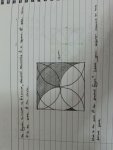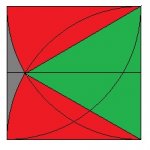You are using an out of date browser. It may not display this or other websites correctly.
You should upgrade or use an alternative browser.
You should upgrade or use an alternative browser.
Plz help me find the shaded area... Circle, quadrants n triangles...looks easy but it
- Thread starter Tara
- Start date
What d'heck does "N of yea" mean?
Hello Denis,
i was able to find the big chunk of shaded part but if u look carefully there is an isolated tiny part on the bottom of the figure if I m unable 2 get .. Plz help me find that.
Tara, you stated that you were able to get the [area of the] "big chunk of the shaded part." Well then, so share with us what area you got for that part.Hello Denis,
i was able to find the big chunk of shaded part but if u look carefully there is an isolated tiny part on the bottom of the figure if I m unable 2 get .. Plz help me find that.
Tara, you stated that you were able to get the [area of the] "big chunk of the shaded part." Well then, so share with us what area you got for that part.
Ok I 've got 51.43.. For that big shaded part..
Which is pretty easy..
I actually cut the area of square into half= 72
then figure out the ovals= quart - triangle n multiple 2= 20.57
next subtracted it 2 find the shaded chunk= 51.43
Tara, your computations are approximations. Any type of this problem before that I have done wants the answer exact, including the use of the symbol for pi and/or square roots.Ok I 've got 51.43.. For that big shaded part..
Which is pretty easy..
I actually cut the area of square into half= 72
then figure out the ovals= quart - triangle n multiple 2= 20.57
next subtracted it 2 find the shaded chunk= 51.43
Tara, your computations are approximations. Any type of this problem before that I have done wants the answer exact, including the use of the symbol for pi and/or square roots.
Half Area of square = 12*12=144/2= 72
next I need 2 find the 2 semi ovals in order 2 figure out the shaded c
chunk which is
quarter - triangle= (1/4*pie*6^2)-(1/2*6^2) then multiple by 2 as there is 2 semi 1/2 ovals across the figure= 20.57
next I minus 2 find the shaded chunk= 72-20.57= 51.43.
All I need now is 2 figure out the tiny part...
Please spell out all of your words (or at least use standard abbreviations). In this case, please spell out the word "to" instead of using text speak.Half Area of square = 12*12=144/2= 72
next I need > > 2 < < find the 2 semi ovals in order > > 2 < < figure out the shaded c
chunk which is
quarter - triangle= (1/4*pie*6^2)-(1/2*6^2) then multiple by 2 as there is 2 semi 1/2 ovals across the figure= 20.57
next I minus > > 2 < < find the shaded chunk= 72-20.57= 51.43.
All I need now is > > 2 < < figure out the tiny part...
Last edited:
Half Area of square = 12*12=144/2= 72
next I need to find the 2 semi ovals areas in order to figure out the shaded
chunk which is
Area of quarter - area of triangle= (1/4*pie*6^2)-(1/2*6^2)
then the answer multiple by 2 [as there are 2 semi 1/2 ovals across the figure]= 20.57
next I minus to find the area of shaded chunk= 72-20.57= 51.43.
All I need now is to figure out the tiny part...
next I need to find the 2 semi ovals areas in order to figure out the shaded
chunk which is
Area of quarter - area of triangle= (1/4*pie*6^2)-(1/2*6^2)
then the answer multiple by 2 [as there are 2 semi 1/2 ovals across the figure]= 20.57
next I minus to find the area of shaded chunk= 72-20.57= 51.43.
All I need now is to figure out the tiny part...
hi MarkFL,
thanks for ur reply, appreciated it however I m unable to get the measurement for the triangle... As only the sides=12 is given.. Are u able to elobrate more on this problem sum.. Thanks.
The diagram I gave is 1/4 of the total square (by area), so the side lengths of the smaller square are 1/2 that of the total.
i got 5.465 for the tiny part plus the chunk(51.43) I got the answer 56.89....
When the answer is said to be 43.75....
Last edited:
- Joined
- Nov 24, 2012
- Messages
- 3,021
Your result for the smaller shaded portion is too large. I agree with your result for the larger shaded area (at least closely), this area is the area of the square, minus a half-circle and a quarter of the square. Let's call the larger shaded area \(\displaystyle A_1\). I find:
\(\displaystyle A_1=12^2-\left(\frac{1}{2}\pi\cdot6^2+\frac{1}{4}12^2 \right)=108-18\pi\approx51.45\)
So, the given answer is incorrect, if I have interpreted the problem correctly.
Now, for the smaller shaded area \(\displaystyle A_2\), in the diagram I provided, you should see that the green triangle is equilateral, and the two red areas are circular sectors subtending an angle of \(\displaystyle \frac{\pi}{6}\).
What do you find?
\(\displaystyle A_1=12^2-\left(\frac{1}{2}\pi\cdot6^2+\frac{1}{4}12^2 \right)=108-18\pi\approx51.45\)
So, the given answer is incorrect, if I have interpreted the problem correctly.
Now, for the smaller shaded area \(\displaystyle A_2\), in the diagram I provided, you should see that the green triangle is equilateral, and the two red areas are circular sectors subtending an angle of \(\displaystyle \frac{\pi}{6}\).
What do you find?
Your result for the smaller shaded portion is too large. I agree with your result for the larger shaded area (at least closely), this area is the area of the square, minus a half-circle and a quarter of the square. Let's call the larger shaded area \(\displaystyle A_1\). I find:
\(\displaystyle A_1=12^2-\left(\frac{1}{2}\pi\cdot6^2+\frac{1}{4}12^2 \right)=108-18\pi\approx51.45\)
So, the given answer is incorrect, if I have interpreted the problem correctly.
Now, for the smaller shaded area \(\displaystyle A_2\), in the diagram I provided, you should see that the green triangle is equilateral, and the two red areas are circular sectors subtending an angle of \(\displaystyle \frac{\pi}{6}\).
What do you find?
Sorry? U said the green triangle is equilateral?? How can that be possible...? Hmm...
Anyway may I get ur working plz...
- Joined
- Nov 24, 2012
- Messages
- 3,021
Do you see how each side of the triangle is a radius of the circles?
And how the angles subtended by the two red circular sectors must then be \(\displaystyle \displaystyle \frac{\pi}{2}-\frac{\pi}{3}=\frac{\pi}{6}\)
So, use the fact that the area of the green triangle plus the area of the two red sectors plus the area of the gray portion (which you are seeking) add up to the area of the square, which is a quarter of the entire square.
Area of a triangle:
\(\displaystyle A=\dfrac{1}{2}ab\sin(C)\)
Area of a circular sector:
\(\displaystyle A=\dfrac{1}{2}r^2\theta\)
And how the angles subtended by the two red circular sectors must then be \(\displaystyle \displaystyle \frac{\pi}{2}-\frac{\pi}{3}=\frac{\pi}{6}\)
So, use the fact that the area of the green triangle plus the area of the two red sectors plus the area of the gray portion (which you are seeking) add up to the area of the square, which is a quarter of the entire square.
Area of a triangle:
\(\displaystyle A=\dfrac{1}{2}ab\sin(C)\)
Area of a circular sector:
\(\displaystyle A=\dfrac{1}{2}r^2\theta\)
Last edited:
Do you see how each side of the triangle is a radius of the circles?
And how the angles subtended by the two red circular sectors must then be \(\displaystyle \displaystyle \frac{\pi}{2}-\frac{\pi}{3}=\frac{\pi}{6}\)
So, use the fact that the area of the green triangle plus the area of the two red sectors plus the area of the gray portion (which you are seeking) add up to the area of the square, which is a quarter of the entire square.
Area of a triangle:
\(\displaystyle A=\dfrac{1}{2}ab\sin(C)\)
Area of a circular sector:
\(\displaystyle A=\dfrac{1}{2}r^2\theta\)
Hi MarkFL ,
The formulas that you had given me has not been taught to me..
this problem sum is currently for grade 6...
thank you for your help n time.
U = You
ur = your
plz = please
Start now using proper words: may be VERY important at job interviews
Hi Denis
Thank you for ur advice and guidance.
I will seek to change it.
- Joined
- Nov 24, 2012
- Messages
- 3,021
Hi MarkFL ,
The formulas that you had given me has not been taught to me..
this problem sum is currently for grade 6...
thank you for your help n time.
Have you been taught the Pythagorean theorem, and the formula for the area of a triangle:
\(\displaystyle A=\dfrac{1}{2}bh\)
Have you been taught the formula for the area of a circle:
\(\displaystyle A=\pi r^2\)
We can use these instead.
Have you been taught the Pythagorean theorem, and the formula for the area of a triangle:
\(\displaystyle A=\dfrac{1}{2}bh\)
Have you been taught the formula for the area of a circle:
\(\displaystyle A=\pi r^2\)
We can use these instead.
My head is spinning... No Pythagorean theorem taught yet..
however i understand how it is calculated but I have still yet figure out how 2 go about solving ..
may I know the measure ment ... i mean d height n base of the triangle
Last edited:


